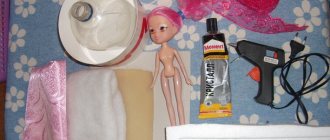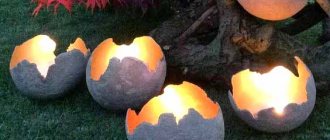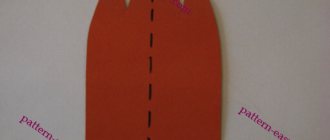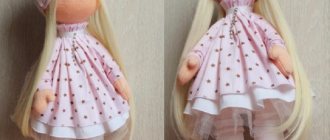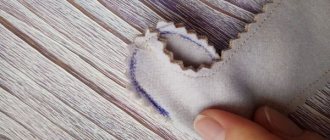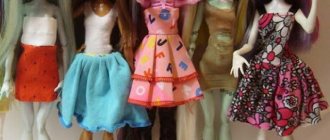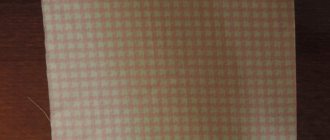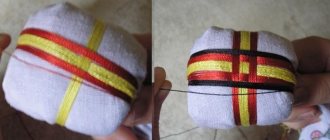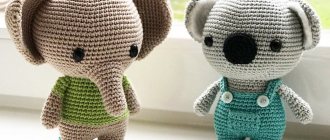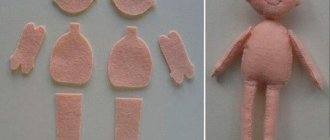According to the eastern calendar, the mistress of 2030 is a yellow dog. Are you already going to the nearest store to look for themed souvenirs? Stop giving unnecessary little things.
Check out a selection of unique master classes and detailed lessons for both beginners and experienced needlewomen. Using them, you can easily prepare original gifts with your own hands.
Making dogs for a tabletop theater
To provide exciting leisure time for children, both in children's institutions of various levels and at home, plot-based puppet theater performances are actively used.
For such entertainment, it is recommended to use both finger theater and its other varieties. To create a puppet theater with your own hands, you can successfully use a variety of types of needlework:
The vast majority of home puppet theater performances are based on the content of folk and original fairy tales, the main characters of which are forest animals or pets. A popular character is the dog puppet.
DIY dog puppet
Materials and tools:
This is an approximate list of materials; you can safely replace the composition with what you have on hand.
Procedure
Paint the rollers the color of your future dog.
To make a pointed muzzle, make 4 cuts on one side of the smaller roll, about 2/3 of the way down. Squeeze so that the cut parts overlap, as in the photo, and glue. You can wrap the muzzle with an elastic band or thread while the glue dries.
Cut a piece from the long roller to create ears. Glue the ears and eyes to the face.
Then everything is simple: make holes in a long roller, attach the legs and tail.
Attach the head to the body with one rope, as in the photo.
LiveInternetLiveInternet
Quote from Roman_FRF
Read in full In your quotation book or community!
Puppets for the pros - 3
Continued
Puppets of animals, birds, fish and insects
LEBEDINSKY A. M., artist 1977
Marionettes , due to the fact that they are controlled by means of strings from above and have greater capabilities at a distance, are more versatile than glove and cane puppets “tied” to the screen bed and to the puppeteer.
Puppets can jump, float in the air or transform in front of the audience.
With the help of animal puppets you can create an original “circus of animals”. Monkeys, butterflies, and horses in the puppet theater are perhaps the most interesting of animal puppets.
Monkey on a trapezoid (Fig. 1).
This doll is very simple in its design. The movement of the doll's limbs should be only in one plane on the sides of the body. The head, neck and torso of the doll are cut out of one piece of wood. The upper limbs are made without bending in the joints with the hands bent so that they fit the lower bar of the trapezoid, the paws are attached loosely to the shoulders by means of a metal rod passing through the shoulders and arms. The lower limbs are also manufactured and attached. For all limbs, recesses must be made in the torso to allow free rotation on the axis at the attachment point. Doll. should be covered with fur and material of the appropriate texture.
The trapezoid is made from two bars, round in cross-section, slightly longer than the width of the doll. The bars are connected by two elastic wires; the distance between the bars should correspond to the height of the doll. The lower ends of the wires are bent inward and tightly inserted into the ends of the lower bar of the trapezoid.
The upper ends of the wires are ring-shaped and should rotate freely in the grooves at the ends of the upper bar of the trapezoid.
Four holes must be drilled in the lower bar of the trapezoid: two for threads coming from the upper limbs, and two for threads from the lower limbs.
The shape for this doll is T-shaped. The length of the horizontal bar may be slightly longer than the length of the trapezoid bar, and the length of the vertical bar can be equal to half the height of the doll with raised upper limbs. The upper end of the vertical bar is attached to the middle of the horizontal bar. The base of the vertical bar of the vaga is attached tightly in the middle of the upper bar of the trapezoid. Thus, the trapezoid and the vaga form one whole (Fig. 2).
This doll is connected to the trapeze vaga with only five threads. Two threads are attached to both ends of the horizontal bar of the trapezoid, going around the upper bar of the trapezoid, passed into the outermost holes in its lower bar of the trapezoid to the palms of the doll. The other two threads start from the same points on the cotton wool, pass through other holes on the bottom bar of the trapezoid to the upper surfaces of the doll's feet. But the fifth thread comes from the top of the doll’s head, goes around the upper bar of the trapezoid, hangs freely and is attached with the other end at the junction of the horizontal strap of the hook with the vertical one. In Fig. 2 shows the main positions of the doll.
Figure one. The doll appears from above, holding onto the bottom bar of the trapezoid. In this position, the vagina is tilted forward as far as possible. The threads from the doll's hands are stretched to the maximum, and the threads from the feet are loosened. The vaga with a trapeze and a doll needs to be rocked.
Figure two. Continuing to swing the trapezoid with the doll with one hand, the puppeteer raises the vaga to a horizontal position and lowers it (the lower limbs of the doll rise and fall). It is better to perform these movements with the doll turned sideways towards the viewer. By raising the vaga to a vertical position, you can pull the lower limbs to the lower bar of the trapezoid (in this position the doll is suspended when it is not working).
Figure three. The vaga is thrown to the other side of the trapezoid. The threads from the doll's lower limbs are tense (the feet are pressed against the trapezoid), and the threads from the hands are loosened (the doll is lowered head down with the upper limbs lowered).
Figure four. From the initial position, swinging the trapeze and the doll, you can lift it so that it balances on the trapeze. To do this, the puppeteer must simultaneously pull the thread from the doll’s head with one hand and hold the vagina in a horizontal position with the other and swing the trapeze. This number can be shown without a screen with naked equipment.
Circus horse (Fig. 3).
The horse's body can be carved from light wood or foam, and the head and legs from hard wood. There should be two loops on the horse’s back, to which threads will be tied, carrying the entire weight of the doll.
In the front of the horse's torso, in the middle of the chest, a notch is made into which the spike of the horse's lower neck is inserted. The horse's neck and chest must be secured with a through pin.
The horse's tail is inserted into the recess in the back of the torso and secured with a pin. The horse's legs may not be very voluminous, and they are attached to the torso, like the head, with wire through pins. All other joints are made into a tenon with eyes. The bends in the doll's front legs should be only backward, and in the back legs - forward.
The vaga for this doll consists of a main horizontal bar equal to the length of the doll. Two short straps for the legs are attached to it from below (see Fig. 3, front and side views). In the hole at one end of the main strap of the wag, a thread coming from the tail is secured using a button or ball. In the middle of the bar, threads from the horse’s back are attached, at the other end of the main bar, a piece of elastic, to which threads from the doll’s head are attached. By pulling the elastic band, the horse's head is tilted.
Two threads are attached to the ends of the bar for the doll's hind legs. One goes straight to the back of the knee joint, the second goes to the other leg, passes through the hole above the “hock” joint and is attached to the back of the hoof. The same must be done with the threads for the hind legs coming from the other end of the bar. Thus, two threads from the hind legs intersect.
One thread is attached to the ends of the bar for the apron of the doll's legs. These threads pass through holes in the front above the “elbow” joints and are secured at the back of the hooves. When the doll is standing, the vaga is in a horizontal position. All threads, except for the crossing threads going to the hooves of the hind legs, are equally tense.
In Fig. 4 shows the main movements of the doll.
Figure one. The horse runs by swinging the main bar of the vaga (vaga in a horizontal position). In this case, one front and one rear leg are raised on one side at the same time. The doll should barely touch the floor.
Figure two . The vaga is tilted down, the torso of the doll takes the same tilt. At the same time, the horse can shake its head (the elastic band is pulled down), raise and lower one of the front legs, raise its tail (pull the corresponding thread).
Figure three. When the wag tilts upward, the horse rears up. You can pull one or both threads from the front legs. By rocking the wag you can move the horse forward and backward on its hind legs. In the same position, the doll can jump over obstacles: the vaga tilts up and down while simultaneously moving the doll in the desired direction.
An interesting trick can be done with a horse without legs (Fig. 5). To disguise the absence of legs on a doll, its body must be covered with a beautiful bright fabric up to an imaginary floor. The doll is made without movement in the neck and tail. It can be made of cloth, stuffed with cotton wool or rags.
The string for this doll is one main strip, to the ends of which two threads from the body are attached. Such a simple doll (of a horse, donkey or other similar animal) with a simple vaga makes it possible to place a human doll on it. If the doll (rider or ballerina) is attached to an animal, then it is enough to attach a short strap to the main strap of the vaga, to which the threads from the human doll will be knitted. If a human doll must also act independently, then it is necessary to make a separate, more complex horizontal line for it. One puppeteer can lead both puppets.
Dog (Fig. 6).
This doll is similar in some details to the animal dolls already described. The attachments of the front and hind legs to the torso are made like those of a monkey, i.e. through through pins. In the dog's torso, indentations are made for the paws, just like a monkey. If the dog should be short, with short legs, then its limbs can be attached like those of a horse, without notches. You can make a dog's paws with bends at the joints, like a horse's. It is advisable to weight the dog’s feet for greater mobility.
The dog doll's neck is made into a separate part with a spike, which is inserted into an eyelet in the doll's head. The base of the neck is connected to the torso by means of two screws with ring-shaped heads. This articulation of the neck with the head and torso gives it greater mobility. The tail is attached to the torso in the same way. The doll is covered with fur or fabric of the appropriate texture.
The vaga for this doll consists of one horizontal bar, the length of the animal’s body. A short strap with an elastic band is attached to one end, to which two threads from the doll's head are tied. Two threads from the back carry the entire weight of the doll. One thread at the end of the thread comes from the doll's tail. If the dog has limbs with bends in the joints. then the vaga should be made as for a horse, with two additional slats for the legs.
This doll is driven by rocking the vagina up and down.
Hare ('Fig. 7).
The design of the hare doll is more complex. It is recommended to make the body of this doll in several layers (see top view, Fig. 7). You need to draw the general outline of the doll’s body and make drawings of each part. The middle part should be made of hard wood, since the threads that bear the main weight of the doll are attached to it. You need to cut an eyelet in it for articulation with a spike from the neck. The parts adjacent to it on both sides can be made of softer wood or foam. Recesses are cut out for the doll’s front legs, and in the outer layers for the hind legs. All layers must be glued and tightened with clamps, and after the glue has dried, the torso must be processed and given the desired shape.
Using the same principle, from three layers, you can make heads for a hare, dog and horse.
The hare's neck is made separately and has two spikes: one spike connects the neck to the doll's head, the other to the body. Both connections are made using pins, which gives the head and neck greater mobility. For the same purpose, it is better to secure the ears loosely with pins in the recesses in the head.
The paws are made with bends at the joints. The front legs can be partially retracted into the recesses of the body. The hind legs have a joint in the bend into a spike with an eye and weights at the ends. They are attached to the body with through pins. The entire doll must be covered with fur or fluffy fabric.
The frame for this doll is horizontal, the length of the doll. At the end of the main bar, a short bar is attached for the hind legs and a thread from the doll’s back at the tail. Another thread connects the doll’s back (closer to the neck) with the vagina. Two threads from the tips of the doll's ears, one thread from the nose and one from the back of the head are tied to an elastic band, which is attached to the other end of the vagina.
When the elastic band is pulled, the head lowers. To raise the doll's head up, you need to pull the thread from the spout. At the same time, the ears lower. If you lift the front end of the vaga, you can sit the doll on its hind legs. By swinging the vaga to the sides, the hind legs are set in motion. The hare moves mainly by jumping. These movements are carried out by rocking the vagina back and forth.
Fish (Fig .
.
This doll can be made from papier-mâché, foam rubber or polystyrene foam. Fish have very limited movements, mainly the movements of the fins and mouth. The lower jaw of the fish is made separately and is held on a pin. For greater mobility, it must be weighted with a weight.
The fish vault is horizontal, made of one strip. Two threads hold the entire body of the doll, and one thread with an elastic band is stretched from the jaw.
If you need to control a school of fish, then you should connect their legs with one common bar and hang the dolls at different levels.
Caterpillar (Fig. 9).
This puppet can be made by stringing elements carved from wood or cut from papier-mâché on a rope in the form of disks with an ever-decreasing diameter. String small balls between their links or tie knots from the same rope. The head and tail are made separately and secured at the ends.
The vaga for this doll consists of two round sticks, which are connected by a piece of soft rubber tube or a spring. Two threads are pulled from the doll to each stick. With the help of such a simple wag, you can give the caterpillar very expressive movements. Puppets of dragons and other fantastic creatures are also made in this way.
Butterfly ('Fig. 10). The abdomen of a butterfly doll or other insects is made of papier-mâché, polystyrene foam or foam rubber and a weight is placed in it, and the wings are made of colored plastics or cardboard. They are attached to the abdomen with soft tissue so that the movements of the butterfly are free. The wings for flying insects are horizontal, made of two slats, cross-shapedly fastened together. An elastic band with a thread going to the abdomen of the insect is attached to the front end of the main bar. From the ends of the other strip there are two threads going to the wings.
When the elastic band is pulled quickly and frequently, the doll's abdomen (thanks to the weight) lowers and rises, creating the impression of an insect fluttering.
Birds (Fig. 11).
Birds can be made from wood or papier-mâché; large ones are preferably made from polystyrene foam, foam rubber or from a fabric shell stuffed with rags. Weights are placed into the body of the flying bird and into the edges of the wings. The wings are loosely attached to the body.
If you are making a bird that flies little (crane or ostrich), then the wings should fit the body. These wings are made from several parts so that they spread out when flying.
The string for the flying bird is a horizontal bar to which two threads from the doll’s body and one thread from the head are tied. A short strip for threads from the wings is tied to a piece of rope in the middle of the strip. To reproduce the flight of a bird, you need to raise and lower the bar and move the wing in the desired direction.
If you want to make a bird that moves on land or water (goose, duck, swan), with a long neck and a movable head, then you need to tie an elastic band with a short strap to the main bar of the vaga, to which you attach two threads from the doll’s head. By pulling the elastic band and wiggling the short bar, you can convey the movements of these birds.
Series of messages “Puppets”:
Part 1 - Vaga puppets (V. M. Sovetov) Part 2 - 4. Dolls and children (plastic wood) ... Part 15 - Puppets for the pros - 1 Part 16 - Puppets for the pros - 2 Part 17 - Puppets for the pros – 3
Dog for puppet theater made from sock
A funny puppet in the form of a dog can be easily created from an ordinary sock. Such a doll is considered to be a mimic doll, because during the performance process it can, in skillful hands, frown, express surprise or dissatisfaction by moving its eyebrows or nose.
The mimic doll will be of interest to children from two years of age. Starting from the age of nine, a child can create it independently and with pleasure act out scenes with dialogues with its help.
To work on such a toy you need:
The description presented above can be used to independently make different models of mimic dogs to organize a fun stage performance with peers or parents.
A mimic cat can also be made using striped socks.
Crochet dog for table theater
For a puppet theater, you can crochet a toy dog. Knitted from cotton or woolen threads, the puppy can be easily put on your hand. The following master class will demonstrate how to make this version of a theatrical puppet.
Of all the available crochet patterns for the proposed work, the optimal one would be single crochet, which is often used to make amigurumi toys.
To work you will need:
First of all, you need to cast on a chain of loops, the length of which will freely wrap around your wrist.
Loops closed in a ring are knitted in a circle with single crochets until the height of the product reaches 5 cm.
At the next stage, to make the body of the toy knitted easier, the fabric is divided into two parts - front and back, cutting the outer loops in each even row.
Taking the holes left on the sides as a basis, we form a circle along their outer loops and tie the dog’s hollow paws, finishing them with several rows of red color, thereby imitating the pet’s “socks.”
From the outermost loops of the hole formed at the top, it is necessary to knit a head, gradually increasing the number of loops towards the middle, and, on the contrary, decreasing the number of loops towards the crown in each subsequent row.
Using the amigurumi principle, we make a small dog’s muzzle from red yarn, and a nose from a piece of black thread.
The muzzle is sewn in the designated place with a hidden seam, the nose and pre-selected plastic eyes are glued.
The final stage is making the dog's ears. They are knitted by casting 10 stitches in several rows:
The finished ears are sewn with a hidden seam on the sides of the dog's head.
A cat can be tied up in a similar way if, for example, a dramatization of the fairy tale “Turnip” is planned.
Features of the doll
The marionette doll has one very important feature that distinguishes it from other toys. A marionette is precisely a theatrical toy that has lived on stage for several millennia. The most skilled masters of making puppets were in Italy, so this country is the ancestor of these dolls. This is where the name “puppet” itself appeared. In Venice there was a custom when several girls were married off at the same time. 12 girls came out of their houses in white dresses and walked to the church, where their grooms were already waiting for them.
Important! Such an event had citywide significance; it was public. Thus, each girl’s family tried to show off their wealth by decorating their bride with gold jewelry.
In 944, when there was a holiday, the lovely brides were kidnapped by pirates who landed on the shore, and then they were taken away on their ships. The suitors chased after them, caught up with their enemies, and avenged the robbery and desecrated honor of the girls. After this incident, the feast of Mary arose in Venice (quite possibly that was the name of one of the girls). Over time, holding this holiday became unprofitable for the city authorities. Then it was decided to make 12 large dolls.
The established ritual was observed. The city treasury did not suffer - the dolls' holiday outfits did not change for many years. Bride dolls were slightly larger than a person; they began to be called large Marias or Marions. Savvy artisans made mini-copies of brides for city residents. Therefore, the little Marys began to be called Puppets. This name has spread throughout the world.
Note! Playing with puppets helps children develop speech, thinking, understanding of the world around them, and curiosity. The art toy teaches independence in decision making, the ability to communicate, find a compromise and evaluate one’s own and others’ actions.
How to make a dog puppet
Puppet toys invariably cause children's delight: it seems that the puppeteer has nothing to do with their movements and what is happening on stage. When a child gets such a doll, he can play with it for hours. And then arrange extraordinary performances for parents and guests.
Today we invite you to make several puppet toys with your own hands. You can also involve a child in their creation: let him take part in the birth of this magical “actor”. It will be all the more amazing to revive a character, invent his character, habits and signature movements!
Puppy puppet toy
You will need:
© Instagram @shuba.katerina
How to do:
Music, costume designs, noise library and much more for a children's performance
Communication
There is currently one guest and no registered users on the site
DOWNLOAD!
PLAYS WITH MUSIC
Our button
If you liked our resource, you can place our button on your website or blog. button html code:
Update: Friends, thanks to your financial help, we were able to completely clear the site of advertising! Thanks to all! We hope that your support will continue to help keep the site clean, without resorting to forced clogging of it with “yellow” garbage.
